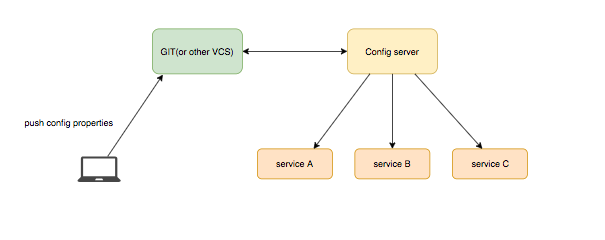Overview: In this tutorial, we will cover the basics of Spring cloud config server and client, where you will set up your cloud config server and access configuration through client services.
What is Spring cloud config?
Spring cloud config provides server and client side support for externalized configuration a distributed system.
Why Spring cloud config?
External configuration is the basic need of almost any application. Now we are leaving in the microservices world, that need external configuration more often. Almost every individual application has some external and dynamic properties that keep updating based on the environment or some period of time. In case of the massive size of services, it is hard to manage or left with creating a custom solution for it.
The dilemma is how we can make our application to adopt dynamic changes more often without investing time into it and with zero downtime. Here spring cloud config comes into the picture. It will help a user to manage their external properties from multiple sources like git, local file system etc. Transfer data into encrypted form and lot more.
How it works?

Above diagram, you can see multiple services that get configuration from config server where config server sync with GIT or any other VCS to get new changes.
Let’s create a simple application, that will take a message from the config server and return through the endpoint.
Implementation of spring cloud config server:
Now I’m going to visit spring initializer page to generate demo project, where I’ve included dependencies of spring ‘web’ and ‘config server’.
Once project imported into IDE, enable config server with ‘@EnableConfigServer’ annotation
@SpringBootApplication @EnableConfigServer public class DemoApplication { public static void main(String[] args) { SpringApplication.run(DemoApplication.class, args); } }
In this example, I’m using local git for demo purpose
#mkdir cloud-config #git init #touch config-client-demo.properties #vi config-client-demo.properties message=Hello World //wq (write and quite vi editor) #git add config-client-demo.properties #git commit -m "initial config"
By default, config server starts on port 8080 as spring boot application.
Here is config server application.properties
server.port=8888 spring.cloud.config.server.git.uri=${HOME}/Desktop/cloud-config
server.port: We use this property to define server port if you do not define it will set 8080 as a default port. Here I’m using the same machine for client and server so one of the port needs to be updated.
spirng.cloud.config.server.git.uri: We define this property to fetch configuration detail from git repository.
Implementation of client application:
Now I’m again going to generate a template application using spring initializer where included ‘web’, ‘client config’ and ‘actuator’ as dependencies. Here ‘actuator’ help us to refresh configuration.
Below is message controller that return message and that message came from config properties, you will notice @RefreshScope annotation that helps to refresh configuration.
@RestController @RefreshScope public class MessageRestController { @Value("${message}") private String message; @GetMapping("/message") String getMessage() { return this.message; } }
Then rename your ‘applcation.properties‘ file to ‘bootstrap.properties‘ and include below config, I’ve defined application name(name of application should accurate to fetch specific data), Configuration URI(which your config server URL that holds properties details) and expose all actuator endpoint that by default disabled
spring.application.name=config-client-demo spring.cloud.config.uri=http://localhost:8888 management.endpoints.web.exposure.include=*
spring.application.name: Accurate name of the configuration file that defined on config server.
spring.cloud.config.uri: Base url of config server
management.endpoints.web.exposure.include: By default actuator’s most features are disabled so use a wildcard to enable all. That actually not needed in case of production.
Run your application and you will see below message.
GET http://localhost:8080/message Response : Hello world
Let’s update the properties file, I’m going to update ‘Hello World’ to ‘Hello Test’
#vi config-client-demo.properties message= Hello Test ... #git add config-client-demo.properties #git commit -m "update message" //Once file updated then 'refresh' configuration
Once you included the @RefreshScope annotation that will expose endpoint for you to refresh application, check below.
POST http://localhost:8080/actuator/refresh
Now again hit your message API
GET http://localhost:8080/message Response: Hello Test
Conclusion: We can use spring cloud config to any kind of application for external, distributed and centralized configuration server. There is no limitation of technology and programming languages. You can apply spring cloud config in other languages as well.
Hope you like this tutorial.
Follow @nikeshpathak